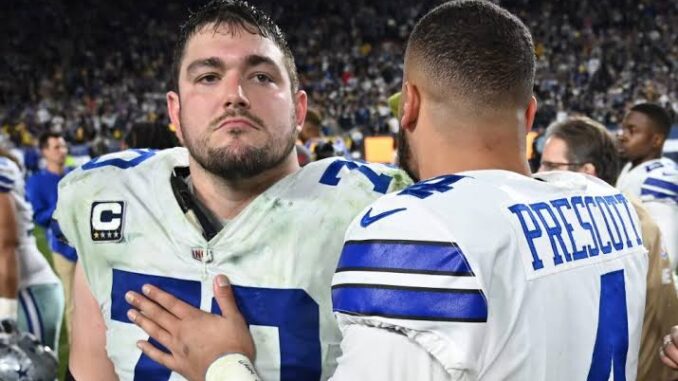
JUST NOW:Zack Martin’s Retirement and Its Impact on the Dallas Cowboys’ 2025 Salary Cap
In the world of the NFL, player retirements don’t just signal the end of an era for a team — they also have significant financial ramifications. One player whose potential retirement could affect the Dallas Cowboys’ salary cap in 2025 is offensive guard Zack Martin. As one of the NFL’s premier offensive linemen, Martin has been a cornerstone of the Cowboys’ offense for nearly a decade. His retirement could significantly impact the team’s salary cap structure, particularly in the 2025 season. To understand the financial consequences of such a move, it is crucial to look at how player contracts and the salary cap work, the specifics of Martin’s contract, and how the Cowboys might adjust moving forward.
The Basics of the NFL Salary Cap
Before diving into the specifics of Zack Martin’s contract and the impact of his potential retirement, it’s important to understand how the NFL salary cap functions. The salary cap is the limit on the amount of money a team can spend on player salaries in a given season. It is determined by the league’s overall revenue and is designed to promote parity among teams by preventing wealthier franchises from dominating the player market. In 2025, the salary cap is expected to continue to rise due to the increasing revenue generated by TV deals, sponsorships, and other sources. As of the 2024 season, the salary cap sits at approximately $224 million, with projections indicating an increase in 2025.
The salary cap is not a static number for each team; rather, it fluctuates based on the players under contract and the structures of those contracts. Contracts in the NFL can include a variety of components such as base salaries, signing bonuses, roster bonuses, and guaranteed money. Teams can manipulate these components to manage their cap space, deferring payments or reworking deals to create room for additional signings. However, the dead money — the portion of a player’s contract that remains on the books even if they are no longer on the team — also factors heavily into the salary cap.

Zack Martin’s Current Contract Situation
Zack Martin has been a key figure in the Cowboys’ offensive line since being drafted in 2014. Widely regarded as one of the best guards in the league, Martin has earned numerous Pro Bowl selections and All-Pro honors. His current contract, a six-year, $84 million extension signed in 2018, keeps him under contract with the Cowboys through the 2024 season. Martin’s cap hit for the 2024 season is set to be around $14 million, but his contract also carries significant dead money if he were to retire or be cut.
In 2023, Martin signed a new deal that adjusted his compensation and salary cap hit for 2024, but his contract still has a substantial amount of guaranteed money left. This means that if Martin were to retire prior to 2025, his departure would trigger some significant dead money for the Cowboys. Dead money is essentially a financial penalty that counts against the salary cap for a player who is no longer with the team. In Martin’s case, retiring would create dead money that would count toward the Cowboys’ 2025 salary cap, potentially complicating the team’s financial flexibility in that year.
Dead Money Impact of Zack Martin’s Retirement
If Zack Martin decides to retire after the 2024 season, the Dallas Cowboys would still be on the hook for a portion of his contract in terms of dead money. While the exact figure will depend on the structure of Martin’s contract at the time, it’s safe to assume that it could be in the range of $10 million or more. This dead money would count toward the Cowboys’ 2025 salary cap, effectively reducing the available space the team has to sign new players or retain existing ones.
The Cowboys have long been known for their ability to manage cap space creatively. Over the years, they have restructured contracts, converted base salaries into signing bonuses, and employed various strategies to avoid cap penalties. However, dead money can limit these options, especially when a key player like Martin retires and leaves behind a significant financial burden. The 2025 salary cap could potentially be impacted by this dead money, reducing the team’s ability to pursue high-profile free agents or lock up emerging stars on the roster.
How the Cowboys Can Adjust
The Cowboys’ front office, led by owner Jerry Jones and general manager Stephen Jones, is no stranger to the challenges of managing the salary cap. If Martin retires and leaves behind dead money, the Cowboys will likely look for ways to offset that impact. One option is restructuring the contracts of other high-paid players, such as quarterback Dak Prescott, linebacker Micah Parsons, or wide receiver CeeDee Lamb. By converting base salaries into signing bonuses or extending contracts, the Cowboys could create immediate cap space to help offset the hit from Martin’s retirement.
Another strategy the team might consider is cutting or trading players with high cap hits but low performance, in order to free up space for other priorities. Additionally, the Cowboys could focus on drafting and developing young talent, which would allow them to balance out their roster without having to spend big money on free agents. The team has historically been successful in the draft, with key contributors coming from recent classes.
Long-Term Impact on the Cowboys’ Cap Space
Beyond just the 2025 season, Zack Martin’s potential retirement would have long-term implications for the Cowboys’ financial outlook. While the immediate cap hit in 2025 may be manageable through restructuring and other adjustments, Martin’s departure also signals the need for the Cowboys to find a replacement at the guard position. Whether through the draft, free agency, or internal development, the team will need to invest in finding a suitable replacement for one of the league’s best guards.
The Cowboys’ salary cap situation in the years following Martin’s retirement will depend on the team’s ability to manage existing contracts, avoid further dead money penalties, and identify young talent to step into key roles. As with most teams, the Cowboys’ success in the post-Martin era will hinge not only on the performance of individual players but also on the strategic management of their finances.
Conclusion
Zack Martin’s retirement would undoubtedly leave a massive void on the field for the Dallas Cowboys, but it would also create significant challenges for the team in terms of their salary cap space in 2025. While the Cowboys have shown a knack for navigating the intricacies of the salary cap, the dead money created by Martin’s contract could complicate their plans. However, with careful management, a strong draft, and possibly some restructuring of existing contracts, the Cowboys can weather the financial storm and continue to be competitive in the years ahead. Martin’s legacy will live on in the Cowboys’ offensive line, but the team’s ability to adapt to his retirement could determine their future success.
Leave a Reply